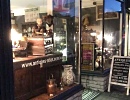Contact Seller
Westbank Antiques
Tel0151 6510522or07450873305Please quote Antiques Atlas.


 Pair Of Antique Ornithology Books, English, 2 Vols
Pair Of Antique Ornithology Books, English, 2 Vols
 Antique Needlework Encyclopaedia, English
Antique Needlework Encyclopaedia, English
 Vintage Reference Book, Wild Flowers
Vintage Reference Book, Wild Flowers
 Antique Badminton Library Book, Fishing, Reference
Antique Badminton Library Book, Fishing, Reference
 1929 Jane Austen Set 5 X Vols Illustrated Ed.
1929 Jane Austen Set 5 X Vols Illustrated Ed.
 1953 Signed Edmund Hillary 1st Ed. High Adventure
1953 Signed Edmund Hillary 1st Ed. High Adventure
 1963 Scarce Ray Bradbury First Edition Novel
1963 Scarce Ray Bradbury First Edition Novel
 1953 Agatha Christie 1st Edition Crime Novel
1953 Agatha Christie 1st Edition Crime Novel
 1960 Agatha Christie 1st Edition Crime Novel
1960 Agatha Christie 1st Edition Crime Novel
 1958 Agatha Christie 1st Ed Ordeal by Innocence
1958 Agatha Christie 1st Ed Ordeal by Innocence
 Antique Book Set, 13 Vols Charles Dickens Novels
Antique Book Set, 13 Vols Charles Dickens Novels
 Antique Book, The Life of Charles Dickens
Antique Book, The Life of Charles Dickens
Non UK callers :
+44 151 6510522
or +44 7450873305
or +44 7450873305
The Bishops Bible 1575 Quarto


A wonderful and rare 16th Century Bishops Bible or Treacle Bible
Imprinted London 1575 Richard Jugge
Bible in English
Quarto Small Folio 11 x 8 x 3 inches
Red end papers
Many more images are available upon request.
The bishops of the Church of England were greatly distressed by the ready availability and rising popularity of the Geneva Bible after its publication in 1560. This was not due to the textual translation of the Geneva Bible itself, but because of its extensive annotations that espoused Reformation theology. The accuracy of the Geneva translation to the original languages of Hebrew and Greek actually showcased the inadequacy and deficiency of the Great Bible translation (1539) that was still the major translation being used in the Anglican churches. The Old Testament portion of the Great Bible was primarily an English translation from the Latin Vulgate.
The interpretive commentaries in the column notes of the Geneva Bible were extremely critical of the hierarchically organized church (whether Anglican or Roman Catholic). The Anglo-Catholic Episcopal bishops were threatened by the Calvinist emphasis on a Presbyterian form of church polity featuring involvement of lay elders. They were intent on maintaining their control and developing an ecclesiastically authorized English Bible translation acceptable for the national Church of England.
Following the lead of the Archbishop of Canterbury, Matthew Parker (1504-1575), seventeen Anglican bishops banded together to produce and publish a new English Bible for the English churches that was to have "no bitter or controversial annotations to the text." Published as “The holie Bible, conteynyng the Olde Testament and the newe, Imprinted at London by Richard Jugge, printer to the Queenes Maiestie. Cum privilegio Regiae Maiestatis. London, 1575” it was popularly referred to as “The Bishops’ Bible.”
This Bishop’s Bible suffered from very uneven translation quality. Many portions of the Old Testament and Apocrypha have little variance from the Great Bible (based largely on the Vulgate), because none of the bishops were Hebrew scholars. The translation of the Psalms was extensive, but so awkward and unacceptable that they were discarded by 1577. In addition, Edmund Grindal (1519-1583), Bishop of London, was a Puritan sympathizer, and the portions that he was responsible for translating resemble the text of the Geneva Bible.
First published in 1568, the initial edition had a portrait of Queen Elizabeth (1568-1603 on its title page, though it was not formally dedicated to her. The Convocation of Canterbury in 1571 ordered that each Archbishop and Bishop "should place a copy in the dining room of his house, each cathedral and, as far as possible, each church should possess a copy" of the Bishops’ Bible. Due to its obvious imperfections the Bishops’ Bible was substantially revised in 1572, adding the Psalms from the Great Bible and using more ecclesiastical language (such as the word “charity” in I Corinthians 13).
The Bishops’ Bible never did become a popular English Bible among the people. Though nineteen editions were printed between 1568 and 1607, it was primarily printed as a pulpit bible for the Anglican clergy. The last complete edition with both testaments was printed in 1602. Despite the incompetence of its scholarship and its unpopularity among English scripture readers, the Anglican bishops pressed on in their objective to counter the Geneva Bible, using the 1602 edition of their Bishops’ Bible as the required “rough draft” for the next edition authorized by King James I in 1604. The translators of the King James Bible (1611) were instructed to follow the text of the Bishops’ Bible wherever possible.
The Bishops’ Bible is often referred to as the “Treacle Bible” because of its translation of Jeremiah 8:22, “Is there not tryacle at Gilead?” (also Jere. 46:11 Ezek. 27:27). The word “treacle” was used in early English vocabulary to refer to a “cure-all” or to “molasses.” It had been used previously in Beck’s revision of the Thomas Matthew Bible in 1549. The King James Bible translated the verse, “Is there no balm in Gilead?”
PriceSold Dimensions11 x 8 x 3 inches Date 1575 16th Century Antiques Origin English Condition In very good condition Item code as610a229 / aa217 Status Sold
SellerWestbank Antiques
View all stock from
Westbank Antiques

 Private dealer, By appointment only.
Private dealer, By appointment only.
Hoylake, Wirral
Merseyside
North West England
Tel : 0151 6510522
or : 07450873305
Non UK callers : +44 151 6510522 or +44 7450873305
Imprinted London 1575 Richard Jugge
Bible in English
Quarto Small Folio 11 x 8 x 3 inches
Red end papers
Many more images are available upon request.
The bishops of the Church of England were greatly distressed by the ready availability and rising popularity of the Geneva Bible after its publication in 1560. This was not due to the textual translation of the Geneva Bible itself, but because of its extensive annotations that espoused Reformation theology. The accuracy of the Geneva translation to the original languages of Hebrew and Greek actually showcased the inadequacy and deficiency of the Great Bible translation (1539) that was still the major translation being used in the Anglican churches. The Old Testament portion of the Great Bible was primarily an English translation from the Latin Vulgate.
The interpretive commentaries in the column notes of the Geneva Bible were extremely critical of the hierarchically organized church (whether Anglican or Roman Catholic). The Anglo-Catholic Episcopal bishops were threatened by the Calvinist emphasis on a Presbyterian form of church polity featuring involvement of lay elders. They were intent on maintaining their control and developing an ecclesiastically authorized English Bible translation acceptable for the national Church of England.
Following the lead of the Archbishop of Canterbury, Matthew Parker (1504-1575), seventeen Anglican bishops banded together to produce and publish a new English Bible for the English churches that was to have "no bitter or controversial annotations to the text." Published as “The holie Bible, conteynyng the Olde Testament and the newe, Imprinted at London by Richard Jugge, printer to the Queenes Maiestie. Cum privilegio Regiae Maiestatis. London, 1575” it was popularly referred to as “The Bishops’ Bible.”
This Bishop’s Bible suffered from very uneven translation quality. Many portions of the Old Testament and Apocrypha have little variance from the Great Bible (based largely on the Vulgate), because none of the bishops were Hebrew scholars. The translation of the Psalms was extensive, but so awkward and unacceptable that they were discarded by 1577. In addition, Edmund Grindal (1519-1583), Bishop of London, was a Puritan sympathizer, and the portions that he was responsible for translating resemble the text of the Geneva Bible.
First published in 1568, the initial edition had a portrait of Queen Elizabeth (1568-1603 on its title page, though it was not formally dedicated to her. The Convocation of Canterbury in 1571 ordered that each Archbishop and Bishop "should place a copy in the dining room of his house, each cathedral and, as far as possible, each church should possess a copy" of the Bishops’ Bible. Due to its obvious imperfections the Bishops’ Bible was substantially revised in 1572, adding the Psalms from the Great Bible and using more ecclesiastical language (such as the word “charity” in I Corinthians 13).
The Bishops’ Bible never did become a popular English Bible among the people. Though nineteen editions were printed between 1568 and 1607, it was primarily printed as a pulpit bible for the Anglican clergy. The last complete edition with both testaments was printed in 1602. Despite the incompetence of its scholarship and its unpopularity among English scripture readers, the Anglican bishops pressed on in their objective to counter the Geneva Bible, using the 1602 edition of their Bishops’ Bible as the required “rough draft” for the next edition authorized by King James I in 1604. The translators of the King James Bible (1611) were instructed to follow the text of the Bishops’ Bible wherever possible.
The Bishops’ Bible is often referred to as the “Treacle Bible” because of its translation of Jeremiah 8:22, “Is there not tryacle at Gilead?” (also Jere. 46:11 Ezek. 27:27). The word “treacle” was used in early English vocabulary to refer to a “cure-all” or to “molasses.” It had been used previously in Beck’s revision of the Thomas Matthew Bible in 1549. The King James Bible translated the verse, “Is there no balm in Gilead?”
PriceSold Dimensions11 x 8 x 3 inches Date 1575 16th Century Antiques Origin English Condition In very good condition Item code as610a229 / aa217 Status Sold
View all stock from
Westbank Antiques

 Private dealer, By appointment only.
Private dealer, By appointment only.Hoylake, Wirral
Merseyside
North West England
Tel : 0151 6510522
or : 07450873305
Non UK callers : +44 151 6510522 or +44 7450873305
You may also be interested in
 Pair Of Antique Ornithology Books, English, 2 Vols
Pair Of Antique Ornithology Books, English, 2 Vols
 Antique Needlework Encyclopaedia, English
Antique Needlework Encyclopaedia, English
 Vintage Reference Book, Wild Flowers
Vintage Reference Book, Wild Flowers
 Antique Badminton Library Book, Fishing, Reference
Antique Badminton Library Book, Fishing, Reference
 1929 Jane Austen Set 5 X Vols Illustrated Ed.
1929 Jane Austen Set 5 X Vols Illustrated Ed.
 1953 Signed Edmund Hillary 1st Ed. High Adventure
1953 Signed Edmund Hillary 1st Ed. High Adventure
 1963 Scarce Ray Bradbury First Edition Novel
1963 Scarce Ray Bradbury First Edition Novel
 1953 Agatha Christie 1st Edition Crime Novel
1953 Agatha Christie 1st Edition Crime Novel
 1960 Agatha Christie 1st Edition Crime Novel
1960 Agatha Christie 1st Edition Crime Novel
 1958 Agatha Christie 1st Ed Ordeal by Innocence
1958 Agatha Christie 1st Ed Ordeal by Innocence
 Antique Book Set, 13 Vols Charles Dickens Novels
Antique Book Set, 13 Vols Charles Dickens Novels
 Antique Book, The Life of Charles Dickens
Antique Book, The Life of Charles Dickens







